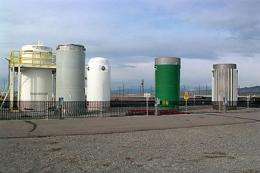Idaho researcher building used nuclear fuel sensor

Much of the 6,200 metric tons of used nuclear fuel generated by U.S. power plants over the last 40 years is stored safely in giant stainless steel casks. Darryl Butt, a Boise State University professor, is part of a team researching whether it can be stored that way for at least 60 more.
"It's a multidisciplinary project involving a number of universities," said Butt, who leads the Center for Advanced Energy Studies' advanced materials research initiative and is a CAES associate director. "It's really looking at how we can store this fuel safely for many decades."
Butt's portion is to develop a sensor array that could detect any changes to the used fuel or cask from the inside out. Heat from used fuel could power the sensor, which would be placed inside or near casks and transmit information about temperature, corrosion, radiation, gas evolution, global position and other conditions so they could be monitored remotely for years to come.
"The goal is to understand what is happening inside those casks and how the fuel and materials break down over time," Butt said. "The sensors would detect any changes or anomalies, which could indicate a problem within the cask or with the spent fuel. It would allow utilities and regulators to head off a leak or any other problems that could arise."

The United States has long grappled with how to handle used nuclear fuel. Most commercial nuclear power plants began storing used fuel rods in onsite pools with the expectation they eventually be reprocessed. However, U.S. policymakers moved away from reprocessing in the late 1970s, forcing commercial plants to store used fuel on site until a permanent disposal site was created.
As their pools filled, power companies turned to dry storage casks on cement pads. The containers are overseen by the Nuclear Regulatory Commission and licensed to store fuel rods for 60 years. Some spent rods are now 30 to 40 years old.
There are no known containment failures associated with dry cask storage, and the focus is now on whether used nuclear fuel can be stored safely in casks for 100 years or more.
But many technical issues remain, such as understanding how the used fuel and containers degrade over time.
That's where Butt and the rest of the research team come in. CAES is a collaboration between Idaho National Laboratory and Idaho's three public research universities. Butt's team — made up of university and national laboratory researchers, in collaboration with industry partners — is developing predictive tools that will help reveal what, if any, changes are occurring inside the casks.
In addition to a sensor, a Texas A&M-led team is researching how the cladding (the protective tubing that surrounds nuclear fuel rods), the fuel and fuel assemblies break down and when materials inside casks start to corrode.
Sean McDeavitt, a Texas A&M professor who is leading the 3-year, $4.5-million project, said the goal is to understand how long the casks hold up, if used fuel can be transported safely or transferred to a new container, and to monitor for leaks.
"This project addresses one of the biggest issues the U.S. nuclear industry is facing right now," he said. "Until there is an underground repository of some sort for this fuel, the commercial nuclear industry needs a way to store it for years and years."
Provided by Idaho National Laboratory

















